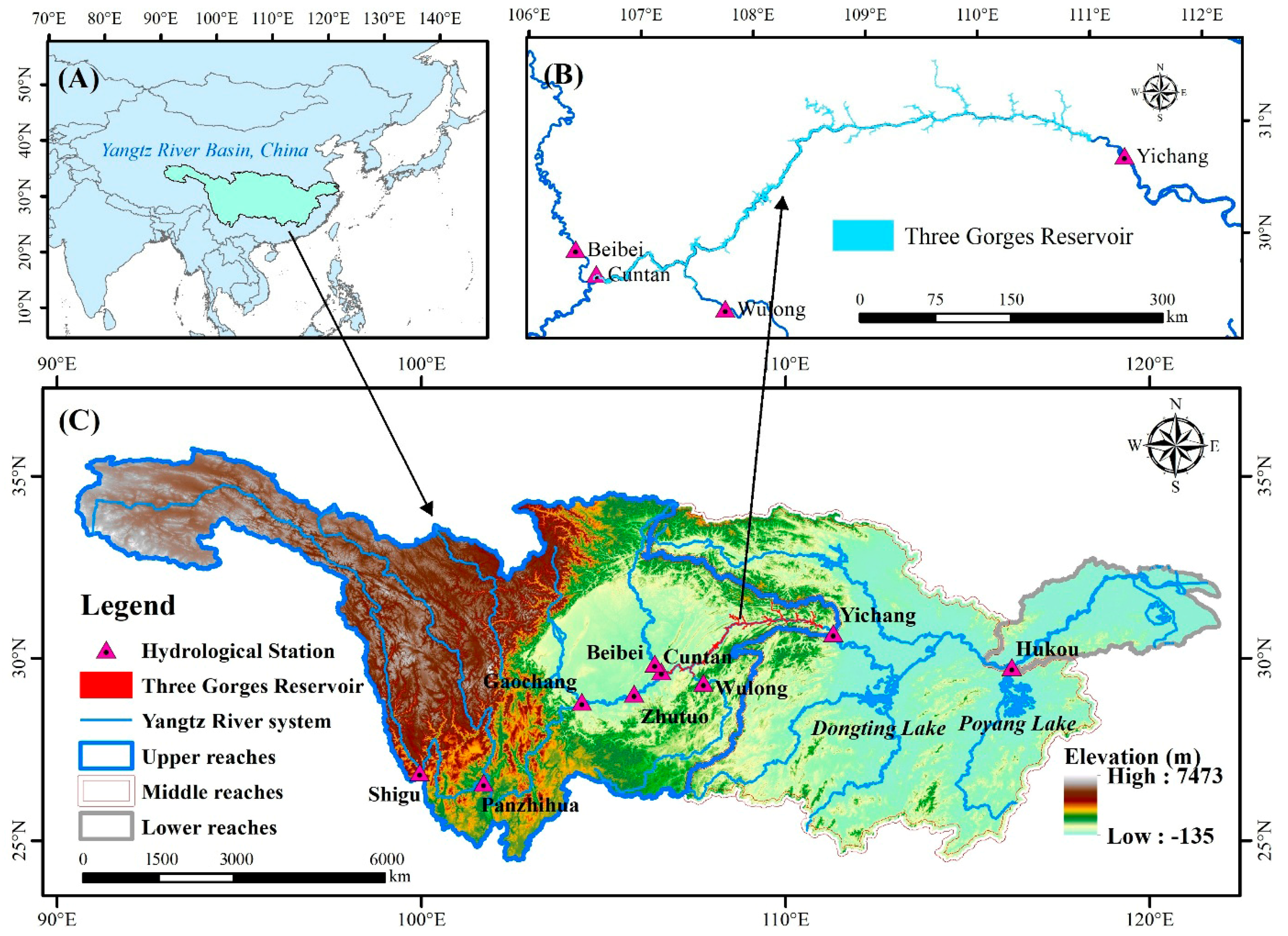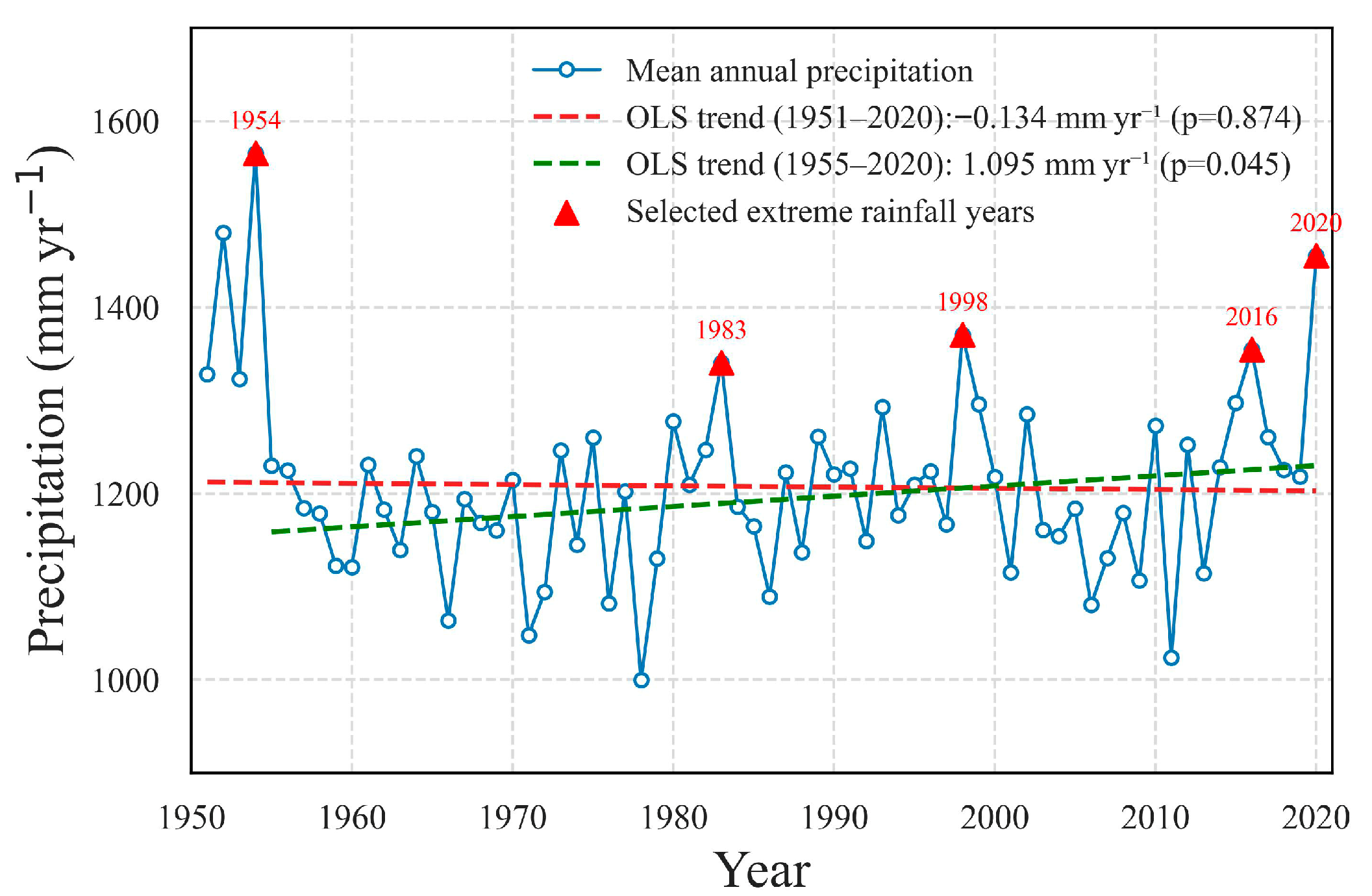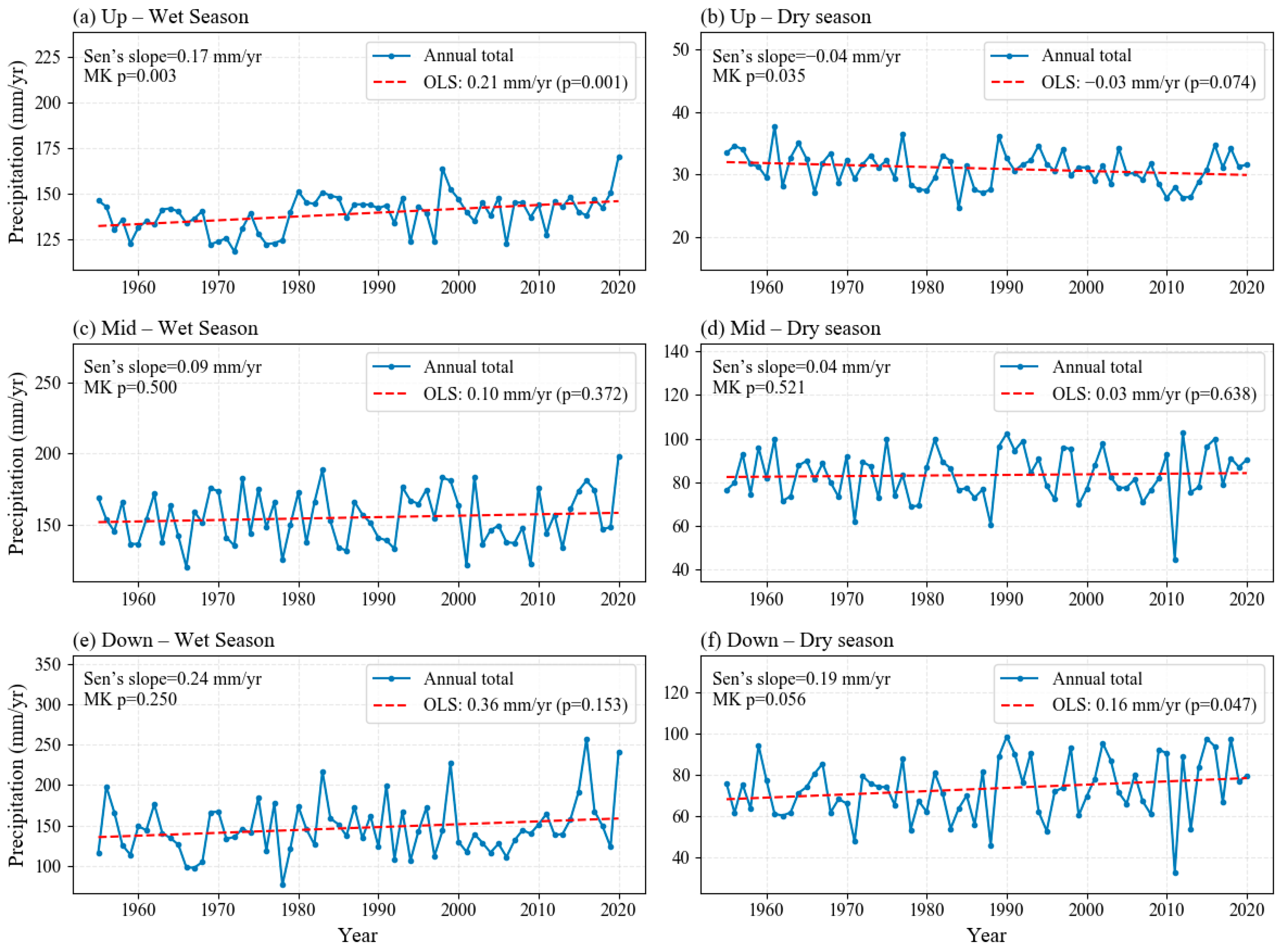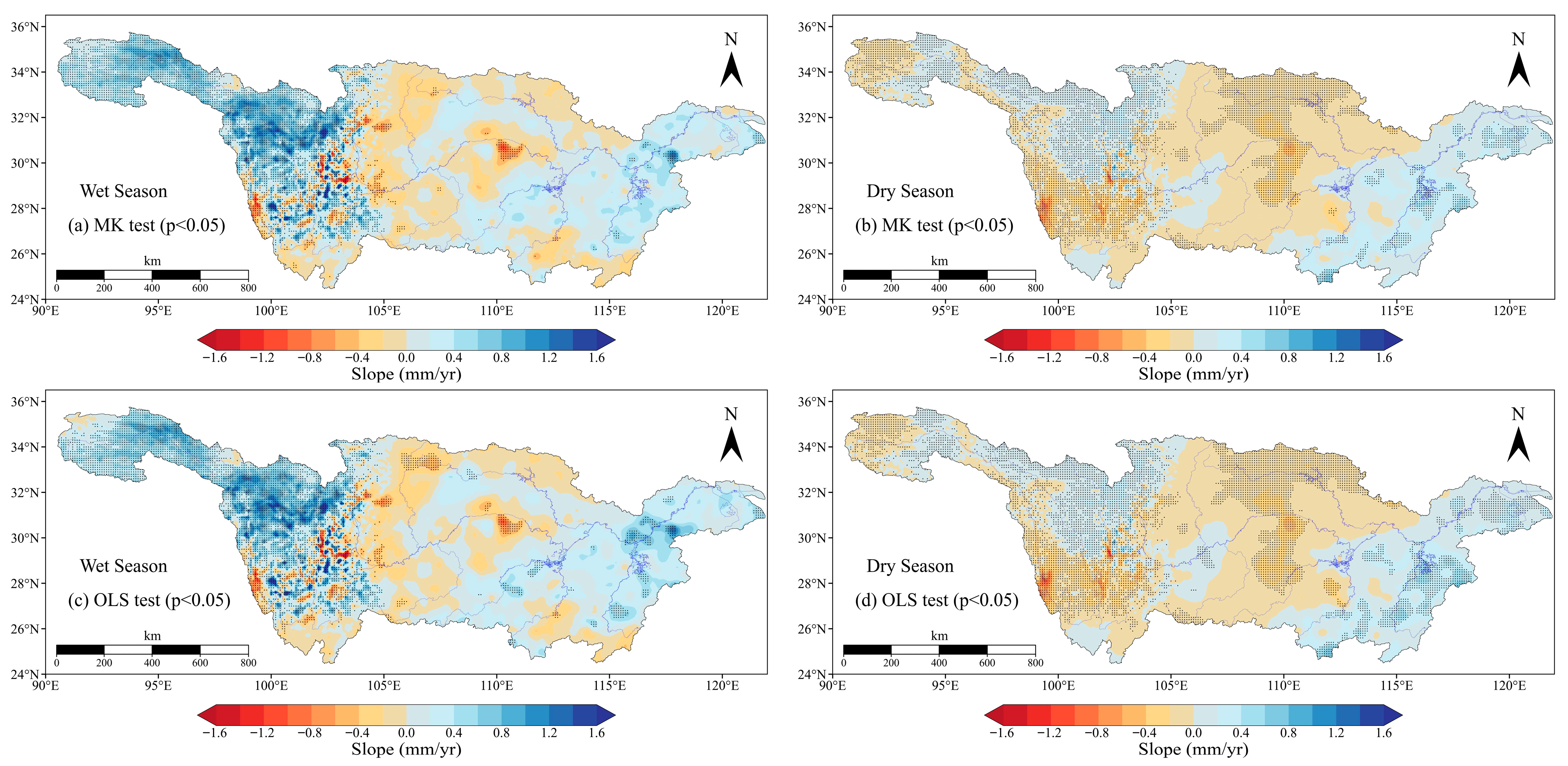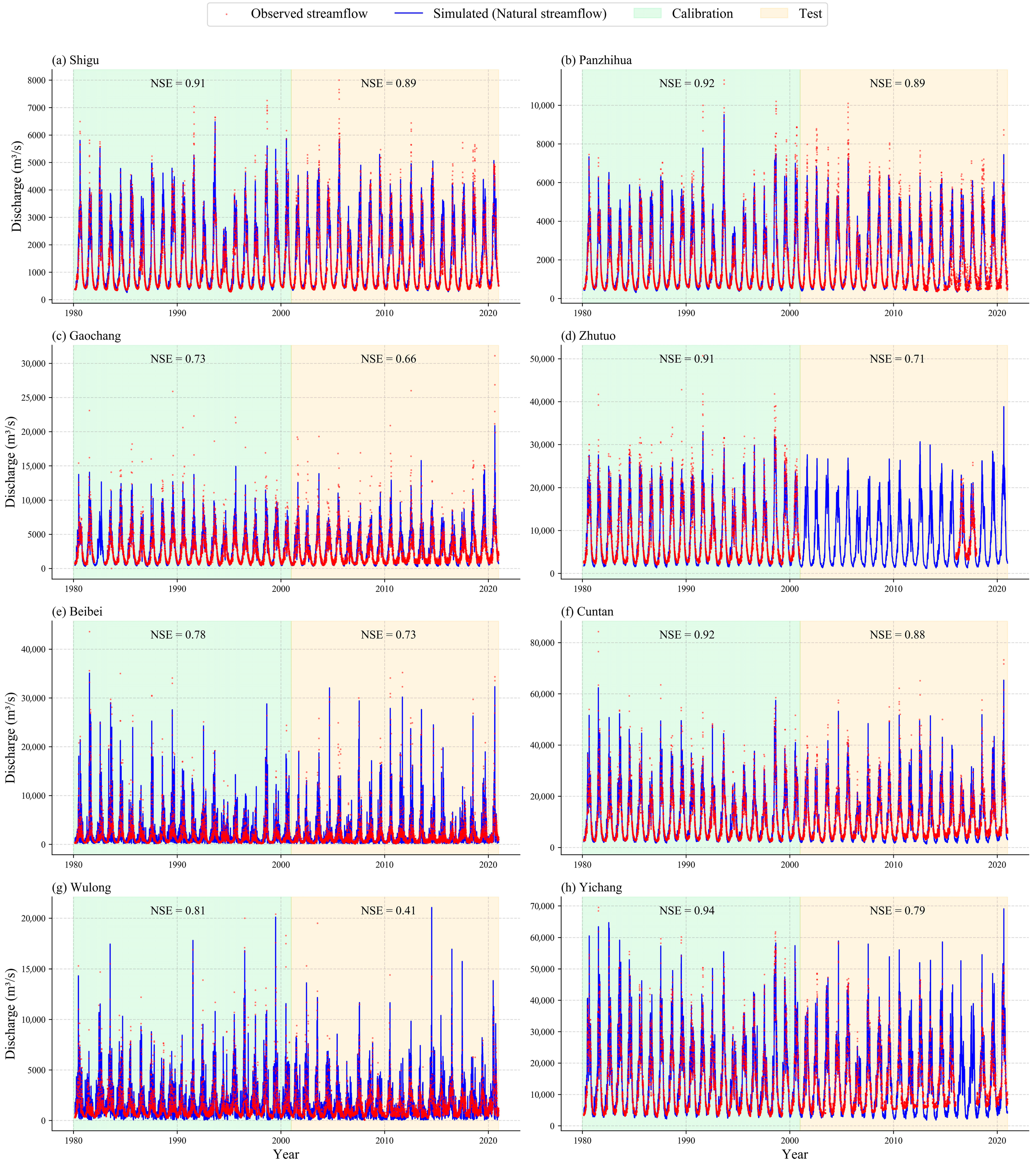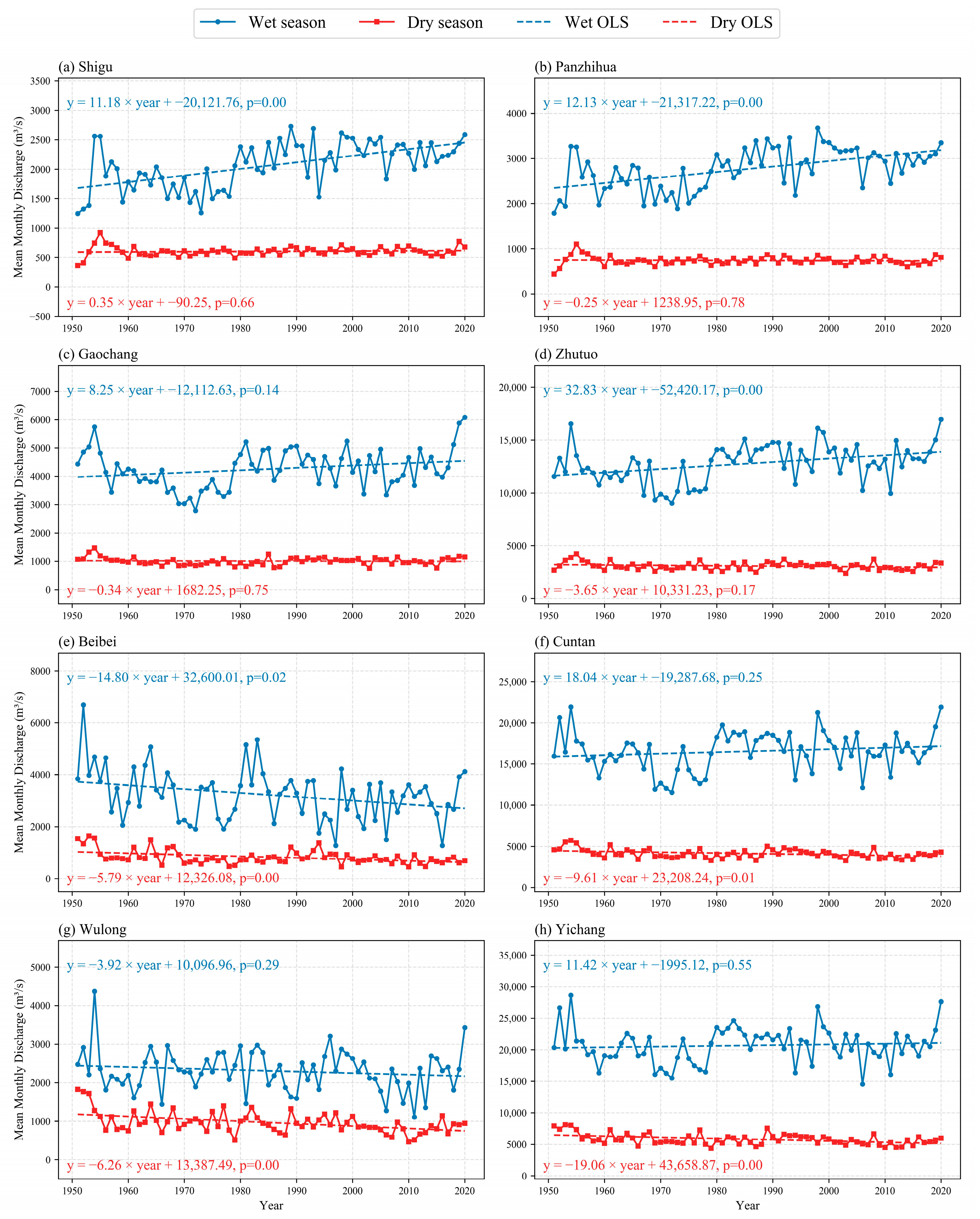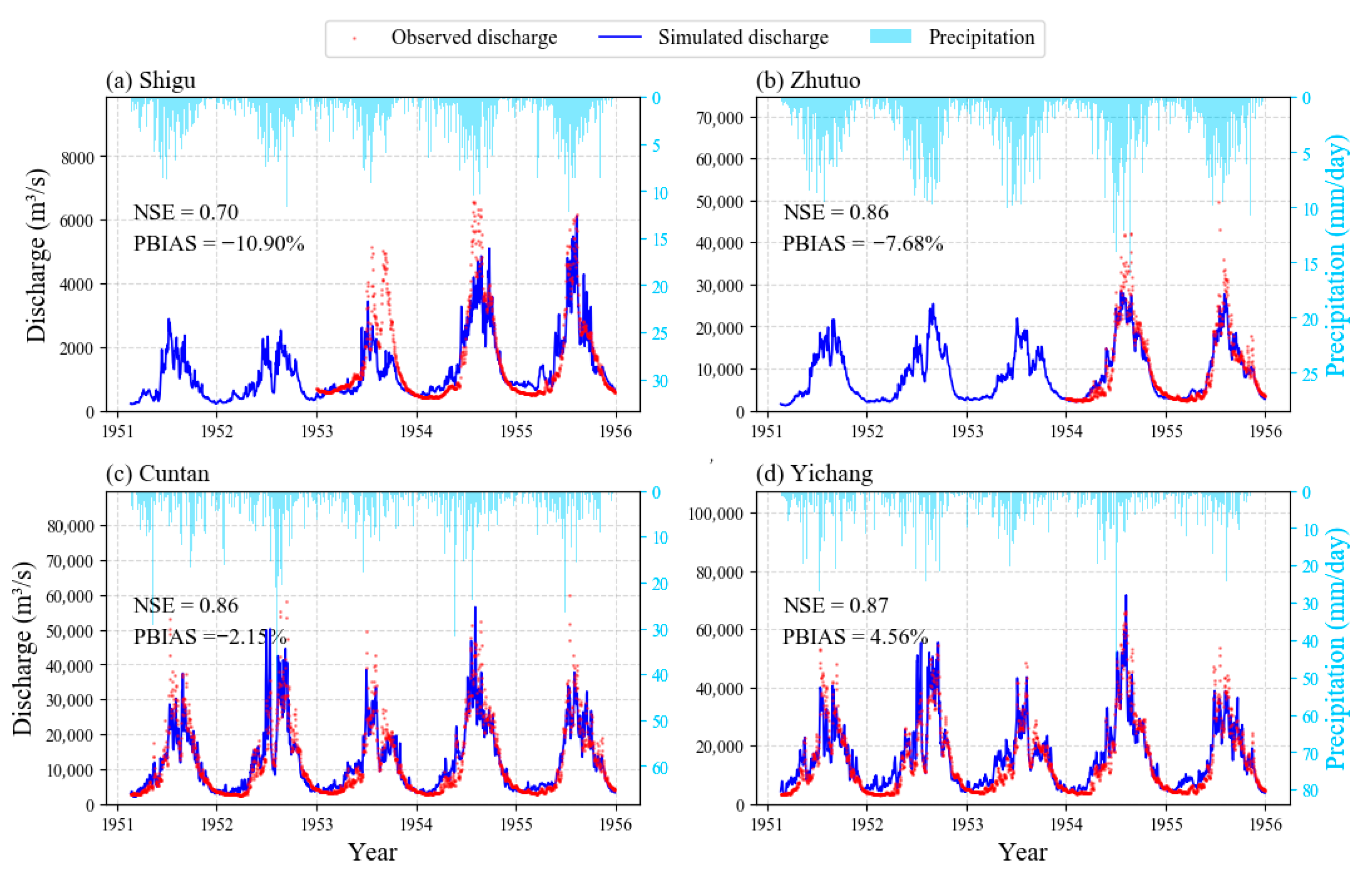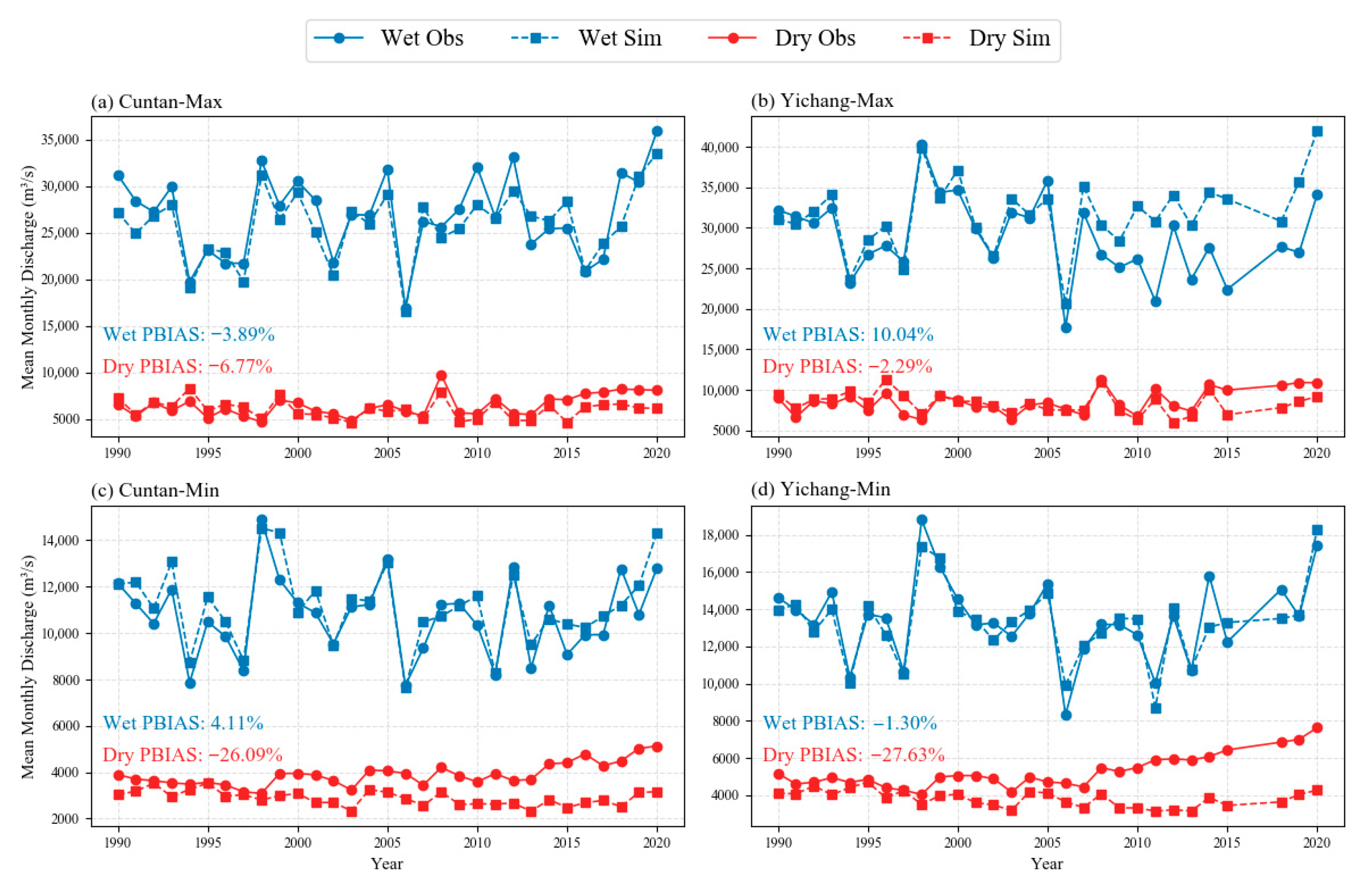1. Introduction
The Yangtze River Basin is the largest and most water-abundant river system in China, covering an area of over 1.8 million km
2. It plays a critical role in sustaining water security for nearly one-third of the country’s population and economic activities, particularly in central and eastern regions. However, the basin has long experienced frequent floods and droughts, posing persistent challenges for water resources management, flood control, and drought mitigation. Under the influence of global warming, the climate system has undergone significant changes, and the global hydrological cycle has become more intense [
1,
2]. This is manifested in the increase in atmospheric water vapor and the growing frequency of extreme climatic events. Consequently, regional precipitation and temperature patterns in the Yangtze River Basin have changed notably. These shifts, together with intensified human activities, have had profound effects on the hydrological regime of the basin. As a result, changes in water availability and aquatic ecosystems in the Yangtze River Basin have become a major concern among researchers in China and worldwide [
3,
4,
5,
6,
7].
Previous research has suggested that annual precipitation across the Yangtze River Basin showed no significant long-term trend during 1955–2011. Nevertheless, precipitation was responsible for approximately 80 percent of the variability in streamflow [
8]. This highlights that, despite increasing human influence, precipitation remains a key driver of streamflow change and a critical factor in flood and drought management within the basin. Numerous studies have investigated precipitation and extreme climate trends at various spatial and temporal scales. For instance, Jiang et al. [
9] analyzed data from 147 stations between 1961 and 2000, revealing a significant increase in summer precipitation and in the frequency of heavy rainfall events. Similarly, Buda et al. [
10] found, based on records from 51 stations (1951–2002), that summer precipitation had increased, rainfall in adjacent months had declined, and extreme events had become more frequent across most regions of the basin. Sun et al. [
11] observed a declining trend in annual precipitation over the upper Yangtze Basin from 1961 to 2005, mainly attributed to reductions in winter and spring rainfall. In addition, several studies have identified the El Niño–Southern Oscillation as a key factor influencing precipitation variability in the region [
12]. However, most of these analyses rely on station data, which are spatially limited, particularly in the mountainous headwater regions of the upper basin. Due to sparse station coverage and complex topography, existing studies have not adequately captured the pronounced spatial heterogeneity of precipitation in these critical upstream areas.
A series of major reservoirs and hydropower projects—such as the Three Gorges, Xiluodu, Xiangjiaba, and Baihetan—have been successively constructed in the Yangtze River Basin, significantly altering its natural streamflow regime. These large-scale engineering interventions, combined with the intensifying effects of climate change, have brought profound changes to the basin’s hydrological processes [
3,
4,
13]. Previous studies have primarily focused on observed streamflow trends or on quantifying the impact of reservoir regulation by comparing regulated and historical streamflow [
9,
14,
15]. For instance, research has indicated that flood-season streamflow in the middle and lower Yangtze increased significantly between 1961 and 2000, potentially due to changes in atmospheric circulation such as a weakening summer monsoon [
9]. Further modeling-based analyses have shown that the Three Gorges Reservoir operation has reduced flood peaks and enhanced low flows during the dry season, altering the seasonal streamflow distribution by 41–61% [
3,
16]. Modeling studies have attempted to isolate the role of reservoir operations from climatic variability by reconstructing natural streamflow conditions [
17,
18,
19]. Chai et al. [
17] suggested that, in extremely dry years, climate variability still plays the dominant role in controlling streamflow patterns at key mainstream stations. Similarly, Zhang et al. [
19] reconstructed natural streamflow at Yichang Station, which is located downstream of the Three Gorges Dam and serves as a key hydrological control station in the upper Yangtze River Basin, playing a crucial role in monitoring and regulating streamflow in this region. They found that reservoir regulation increased streamflow by 400–1900 m
3/s from December to June and reduced it by 300–3400 m
3/s from July to November. However, long-term spatiotemporal trends in natural streamflow under unregulated conditions—particularly across different parts of the upper Yangtze—remain insufficiently understood. Therefore, systematically assessing natural streamflow dynamics and separating the effects of climate change from those of reservoir regulation are crucial for advancing hydrological understanding and improving basin-scale water resources management.
This study focuses on the Yangtze River Basin, utilizing 3-hourly precipitation data and multi-site streamflow observations from 1951 to 2020 to analyze long-term hydrological changes. Two trend detection methods are applied to investigate the spatiotemporal evolution of precipitation and natural streamflow. The objectives are: (1) to characterize the interannual and seasonal trends in precipitation and their spatial distribution across the basin; (2) to simulate natural streamflow at major control stations upstream of Yichang and evaluate its trends at both annual and seasonal scales; and (3) to assess the impacts of human activities by comparing simulated natural streamflow with observed discharge. This comparison is used to quantify the influence of human interventions and to evaluate the reliability of the hydrological model. The study aims to close existing knowledge gaps regarding long-term natural streamflow variability in the Yangtze River Basin, and to provide scientific evidence and technical support for integrated water resources management, reservoir operation optimization, and regional water security policymaking. The novelty of this study lies in the use of long-term high-resolution CMFD v2.0 data, the integration of VIC model simulations with explicit consideration of reservoir regulation, and a comprehensive spatiotemporal assessment of precipitation and natural streamflow trends across the upper Yangtze Basin, which together provide a more refined understanding compared with previous studies.
2. Data and Methods
2.1. Study Area
The Yangtze River originates from the Geladandong Snow Mountain in the Tanggula Range on the Qinghai–Tibet Plateau and flows eastward for approximately 6300 km before emptying into the East China Sea. Its basin covers around 1.8 million km
2, representing nearly one-fifth of China’s total land area [
8,
17]. The Yangtze River Basin spans 19 provinces, autonomous regions, and municipalities, making it one of the most densely populated, economically dynamic, and land use diverse basins in the country.
The Yangtze River Basin is conventionally divided into three sections: the upper reaches (upstream of Yichang Station), the middle reaches (from Yichang to Hukou), and the lower reaches (from Hukou to the river mouth) (
Figure 1). The upper basin is dominated by high plateaus and mountainous terrain, featuring pronounced wet and dry seasons, with streamflow primarily generated by high-altitude snowmelt and summer precipitation. The main channel above Yichang extends approximately 4504 km [
17]. The middle reaches are characterized by relatively flat topography and strong hydraulic connectivity, where streamflow is heavily influenced by major tributary inflows. In contrast, the lower reaches consist of low-lying alluvial plains with dense river networks and are highly susceptible to flood hazards due to concentrated rainfall and tidal backwater effects. Major tributaries such as the Jialing, Min, Tuo, Wu, Han, Xiang, and Gan Rivers play essential roles in regulating and supplementing the mainstem, forming a critical component of the basin’s hydrological system.
The Yangtze River Basin spans multiple climatic zones, ranging from the Qinghai–Tibet Plateau to the central subtropics and southeastern coastal regions, and exhibits distinct gradients in temperature and precipitation. Annual precipitation is relatively low in the western plateau but increases substantially toward the southeast. The basin is strongly influenced by the East Asian monsoon, with the majority of annual rainfall concentrated in June to August. In this study, the wet season is defined as May to October, and the dry season as November to April of the following year [
17].
2.2. Data Collection
The meteorological forcing data used in this study are derived from the China Meteorological Forcing Dataset Version 2.0 (CMFD 2.0), which provides the primary atmospheric input for hydrological simulations in the Yangtze River Basin. This dataset was jointly developed by the National Tibetan Plateau Data Center, the Institute of Tibetan Plateau Research, Chinese Academy of Sciences, and the research group led by Professor Yang Kun at the Department of Earth System Science, Tsinghua University [
20]. CMFD 2.0 integrates ERA5 reanalysis data from the European Centre for Medium-Range Weather Forecasts with dense ground-based observations from the national meteorological network in China. It also incorporates artificial intelligence techniques, such as ISCCP-ITP-CNN and TPHiPr, to improve the accuracy of key variables including radiation and precipitation. Compared to its predecessor CMFD 1.6, which was based mainly on interpolation, CMFD 2.0 offers significant improvements in bias correction and trend fidelity, particularly in regions with complex terrain such as the Tibetan Plateau and the southwestern mountains. The dataset provides a spatial resolution of 0.1° × 0.1° and a temporal resolution of 3 h, making it highly suitable for hydrological modeling in mountainous basins.
Snow processes play a secondary but non-negligible role in the upper Yangtze Basin, particularly in the headwater regions of the Tibetan Plateau and western Sichuan, where seasonal snowmelt contributes to streamflow regulation. However, ground-based snow observations are sparse and unevenly distributed in these mountainous areas, which limits their direct application. Therefore, this study mainly relies on the CMFD v2.0 reanalysis product, which integrates station and satellite data to provide continuous coverage. While this improves the spatial representation of hydroclimatic variables, uncertainties in snow estimation remain and are further discussed in the simulation results.
To represent the spatial variability of natural streamflow, eight major hydrological control stations located on the upper mainstream and first-order tributaries of the Yangtze River were selected: Shigu, Panzhihua, Gaochang, Zhutuo, Beibei, Cuntan, Wulong, and Yichang. Trends in simulated annual natural streamflow at these stations were analyzed over the period 1951–2020. Although water regulation, irrigation, and hydropower infrastructure exist in the upper Yangtze, natural streamflow in this region is generally less influenced by anthropogenic activities compared to the middle and lower reaches, where complex systems of lakes, river–lake connections, and inter-basin transfer projects—such as the South-to-North Water Diversion Project—are present. Therefore, the upper basin offers a clearer representation of the hydrological response to climate forcing. In this study, “natural streamflow” refers to VIC-simulated discharge under unregulated conditions, while “observed streamflow” refers to gauged discharge influenced by both climate variability and human activities. Observed streamflow were obtained from the Yangtze River Hydrological Bureau, and all time series were standardized to daily values from 1 January 1951 to 31 December 2020. Details of the hydrological and water level stations are listed in
Table 1.
2.3. Hydrological Model
The Variable Infiltration Capacity (VIC) model is a physically based, semi-distributed hydrological model widely applied in basin-scale water cycle simulation and climate impact studies [
21,
22]. The VIC model operates on a gridded structure, dividing the study basin into individual computational cells, and explicitly represents key hydrological processes including precipitation, infiltration, surface runoff, groundwater recharge, and evapotranspiration. It accounts for the spatial heterogeneity of land surface characteristics, including soil properties, vegetation types, and topography. A core feature of the model is its runoff generation scheme based on variable infiltration capacity, which enables realistic simulation of streamflow responses under varying land use and climate conditions.
In this study, the VIC model was employed to perform long-term simulations of natural streamflow across the upper Yangtze River Basin. The model was driven by high-resolution meteorological forcing data to evaluate hydrological responses to changes in precipitation. Specifically, the CMFD v2.0 dataset with a spatial resolution of 0.1° × 0.1° (≈10 km) and a temporal resolution of 3 h was used as input. The VIC model was implemented on a 0.125° grid with a 3-hourly time step for runoff generation. For river routing, the Muskingum routing module embedded in the Skyshare system (System for Hydrodynamic Assembling and Realtime Evaluation), developed by the China Institute of Water Resources and Hydropower Research, was applied with a 1-hourly time step. This module adopts a node–river network–sub-basin topology and allows for flood wave propagation simulation in complex branching river systems. In this work, it was used to transform grid-based runoff outputs into streamflow hydrographs at the selected control stations throughout the basin.
2.4. Trend Analysis
The Mann–Kendall (M–K test is a widely used non-parametric method for detecting monotonic trends in time series data without requiring any specific distributional assumptions [
23,
24]. It is particularly well-suited for hydroclimatic variables and has been recommended by the World Meteorological Organization (WMO) for identifying statistically significant increasing or decreasing trends [
25]. In this study, the M–K test was applied to both precipitation and natural streamflow time series, with statistical significance evaluated at the 95% confidence level. The main steps are as follows:
The M–K test assumes that the observations (x
1, x
2, …, xₙ) are independent and identically distributed. The test statistic
is defined as:
where
S follows a normal distribution with a mean of zero and a variance of
;
The standardized test statistic
is calculated as:
A positive
value indicates an upward trend, while a negative
suggests a downward trend. If
exceeds the critical value for a given significance level
, the null hypothesis is rejected, indicating a statistically significant trend in the time series. To estimate the magnitude of the trend, Sen’s slope estimator was applied. This method is robust to outliers and computes the median of all possible pairwise slopes, representing the median rate of change per year [
26]. While the M–K test is powerful for detecting the existence and direction of monotonic trends, it does not quantify their magnitude with confidence bounds. Therefore, a complementary parametric approach was also applied.
In addition to the non-parametric M–K test, this study also employed the parametric Ordinary Least Squares (OLS) linear regression to quantify trends in annual mean precipitation and natural streamflow. To address common issues such as residual autocorrelation and heteroscedasticity in hydrometeorological time series, the Newey–West Heteroskedasticity and Autocorrelation Consistent (HAC) estimator was used to adjust the standard errors of the OLS estimates [
27]. By combining these two complementary methods—M–K and OLS—this study ensures robust detection of both the direction and magnitude of trends, while also mitigating the influence of extreme years and providing a more reliable basis for assessing hydroclimatic changes in the Yangtze River Basin.
2.5. Model Calibration
To ensure accurate simulation of hydrological processes, the Variable Infiltration Capacity (VIC) model requires parameter calibration tailored to the specific characteristics of the target basin. However, due to its large number of parameters and computational intensity, conventional brute-force or global optimization methods are often inefficient—particularly when performing joint calibration at multiple sites, which substantially increases the computational burden.
To address this challenge, a surrogate modeling approach was adopted in this study to calibrate the VIC model at eight representative hydrological control stations in the upper Yangtze River Basin. Surrogate models are statistical or machine learning approximations of high-cost objective functions. Unlike the VIC model, which operates explicitly on a gridded spatial structure, surrogate models do not have a physical spatial scale. Instead, they act as mathematical emulators that learn the relationship between input parameters (e.g., infiltration parameter, baseflow coefficient) and performance metrics such as
NSE and
PBIAS at hydrological stations [
28,
29]. In this study, the surrogate model was trained on a limited set of VIC simulations evaluated at eight representative stations and then used as a computationally efficient proxy during optimization. By iteratively refining the response surface through comparisons with additional VIC runs, the surrogate gradually improved its approximation of the optimal parameter space, thereby substantially reducing the computational burden of calibration without introducing additional spatial complexity. The Python Surrogate Optimization Toolbox (pySOT, version 0.3.3) under Python 3.9.18 was used to implement this framework.
To ensure basin-wide consistency, a hierarchical calibration strategy was employed, progressing from upstream to downstream stations based on hydrological control areas and spatial distribution. This approach ensured spatial coherence in model performance while maintaining computational efficiency. Calibration focused on both natural streamflow accuracy and regional-scale representativeness.
In the VIC model calibration process, several sensitive parameters were adjusted to optimize the simulation performance. The main parameters include the infiltration parameter (
Binf), baseflow parameters (
Ds,
Dm), soil moisture capacity parameter (
Ws), and soil layer thicknesses (
d1,
d2,
d3). Their typical value ranges, physical meaning, and relevance are summarized in
Table 2. These parameters, respectively, control infiltration, baseflow generation, and soil water storage, and have been identified as the most sensitive for basin-scale calibration [
21,
30].
The simulation period was divided into three segments: 1980–2000 for model calibration, 1951–1979 for validation, and 2001–2020 for testing. This setup enabled evaluation under both relatively natural and regulated hydrological conditions. Model performance was assessed using the Nash–Sutcliffe Efficiency (
NSE) and Percent Bias (
PBIAS), with calibration aimed at maximizing
NSE and minimizing
PBIAS across all stations.
where
represents the observed value at time
i,
represents the predicted value at time
i, and
N represents the number of data points.
is the average value of the observation dataset. All values and performance metrics (
NSE,
PBIAS) are based on daily aggregated streamflow series.
4. Discussion
4.1. Reliability Analysis of Precipitation Data from 1951–1955
Trend analysis of basin-wide precipitation revealed anomalously high annual averages during the early 1950s (1951–1955), particularly in 1954. As discussed in
Section 3.1.1, this period coincides with the early stage of China’s national meteorological network, raising concerns about data completeness and accuracy. To further evaluate their reliability, the present study assessed the usability of the CMFD v2.0 precipitation dataset from 1951 to 1955 by testing its performance in hydrological modeling. Specifically, streamflow was simulated using the VIC model at four major mainstream control stations in the upper Yangtze River, and the results were compared with observed streamflow records.
As shown in
Figure 11, while the VIC model notably underestimated some peak flows at Shigu and Zhutuo in certain years, it captured the interannual variability and flow dynamics at downstream stations (Cuntan and Yichang) with high accuracy. One notable case is Shigu Station, where the VIC simulation produced higher flows in 1955 than in 1954. In reality, observed discharge in 1954 was greater, consistent with the catastrophic basin-wide flood. This discrepancy reflects the sensitivity of Shigu, a high-altitude station, to localized precipitation in the upper Jinsha Basin, snowmelt contributions, and antecedent soil moisture conditions. By contrast, the extreme 1954 flood was primarily driven by intense regional precipitation downstream of Shigu, which explains why Zhutuo, Cuntan, and Yichang all recorded much higher flows in 1954 than in 1955.
With respect to the exceptionally high basin-mean precipitation in 1952 and 1954 shown in
Figure 2, the 1954 extreme aligns with well-documented historical records of a catastrophic flood driven by persistent, widespread monsoon rainfall. For 1952, although no basin-wide catastrophic flood is recorded, the observed hydrograph at Cuntan shows a peak nearly as high as in 1954, suggesting that 1952 was likely a wet year in the mid–upper mainstream. This lends plausibility to the high CMFD v2.0 precipitation for 1952. Nevertheless, given limitations in early-station coverage, confirming its meteorological causes and rarity will require future work that cross-validates multiple precipitation datasets and historical archives.
Despite such local anomalies and documented early-period uncertainties, model–data comparisons indicate robust basin-scale behavior. At the downstream stations, the NSE exceeded 0.86 and PBIAS remained within ±10%, indicating strong model performance despite potential errors in precipitation input. These results suggest that, even under early-stage observational conditions, the CMFD v2 dataset can adequately reproduce basin-scale hydrological responses.
Moreover, given that observed streamflow records from 1951 to 1955 are relatively complete and that human disturbances (e.g., regulation, land use change) were minimal during this period, the VIC simulations can be interpreted as close approximations of natural streamflow processes.
In summary, although precipitation data from 1951 to 1955 may contain some uncertainties due to limitations in the early meteorological network, their performance in reproducing hydrological processes at the basin scale is robust. As such, these data are deemed sufficiently reliable for use in long-term hydrological trend analysis and historical scenario reconstruction within the Yangtze River Basin.
4.2. Influence of Human Activities on Natural Streamflow
As one of the most heavily human-influenced basins in China, the Yangtze River has undergone substantial modifications to its natural streamflow regime over the past several decades. These changes have been driven by large-scale water conservancy projects, intensified hydropower development, and widespread land use transformation [
18,
32,
33]. Among these, the operation of the Three Gorges Dam since 2003 has emerged as the most significant anthropogenic intervention, exerting strong regulation effects on both wet- and dry-season streamflow [
14,
15,
19].
To evaluate the influence of major regulation projects on seasonal natural streamflow, this section compares observed and simulated natural streamflow at two key mainstream stations—Cuntan and Yichang—over the period 1990 to 2020. The year 1990 was selected as the starting point because several large reservoirs (e.g., Gezhouba, Ertan, Wujiangdu) had already been constructed and operational in the 1990s, and their regulation effects became increasingly significant during this period, preceding the full operation of the Three Gorges Dam in 2003. These stations were selected due to their strategic location downstream of large hydropower reservoirs and their representativeness in capturing basin-wide regulation effects.
Figure 12 presents the changes in wet-season maximum and dry-season minimum streamflow at both Cuntan and Yichang stations. The results clearly show a divergence between natural and observed streamflow patterns since the early 2000s. At Yichang, observed flood-season peak discharges have been consistently lower than simulated natural values, while dry-season minimum discharges have increased significantly. This shift became particularly pronounced after 2003, coinciding with the full operation of the Three Gorges Dam. The resulting regulation pattern follows a typical reservoir management strategy—storing water during the wet season to attenuate peak discharges and releasing water during the dry season to supplement low flows. Quantitatively, between 1990 and 2020, the wet-season peak discharge at Yichang decreased by 10.04% relative to natural conditions, while the dry-season minimum increased by 27.63%, corroborating previous findings [
16].
A similar pattern is observed at Cuntan, where dry-season streamflow has steadily increased since 1995, with a more rapid rise after 2015. This corresponds to the commissioning of major upstream reservoirs—including Wudongde, Baihetan, Xiluodu, and Xiangjiaba—which have collectively enhanced the inter-seasonal redistribution of flow. From 1990 to 2020, the dry-season minimum discharge at Cuntan rose by 26.09% relative to simulated natural streamflow. Interestingly, the observed wet-season peak discharge at Cuntan is slightly higher than the natural simulation (3.89%), which may reflect coordinated reservoir operations that either delay peak runoff or release water in response to downstream hydropower demand.
In summary, regulation projects—particularly the Three Gorges Dam and the cascade of upstream hydropower reservoirs—have substantially reshaped the seasonal dynamics of natural streamflow in the upper Yangtze mainstream. Wet-season streamflows have been effectively attenuated, while dry-season streamflows have been augmented. Although these anthropogenic modifications support water supply security and hydropower generation, they also pose emerging challenges for maintaining ecological flow regimes and managing flood risks under a changing climate. The findings of this study provide scientific support for adaptive reservoir operation and for enhancing flood and drought risk management strategies under climate change.
4.3. Limitations
This study employed long-term precipitation records and simulated natural streamflow data, in combination with trend detection and spatial analysis, to reconstruct the natural hydrological variability of the upper Yangtze River over the past 70 years as comprehensively as possible. Nonetheless, several limitations remain due to constraints in data availability, model structure, and methodological scope.
First, the natural streamflow series were generated using the VIC model under a specific calibration framework. Although rigorous calibration and validation were conducted at multiple representative stations, the issue of parameter equifinality (non-uniqueness) introduces uncertainty in the simulated results. This is particularly evident in the model’s reduced ability to accurately reproduce extreme peak flows in certain years. In addition, snow processes in the headwater regions of the Tibetan Plateau and western Sichuan are not well constrained due to sparse ground observations, and the reanalysis product may under- or overestimate snow accumulation and melt, which could introduce further uncertainties in seasonal runoff simulations.
Second, long-term projections of hydrological trends are essential for supporting basin-wide flood control, drought mitigation, and water resources planning. Existing studies combining hydrological models with climate projections suggest a likely increasing trend in precipitation in the Laixi River Basin (a key sub-basin in the upper Yangtze), especially during May–September [
34]. Moreover, under projected warming and modest precipitation increases, the upper Yangtze is expected to experience rising mean annual streamflow, enhanced seasonal high flows, and more frequent daily peak discharges throughout the 21st century [
35]. The frequency of extreme floods at key mainstream stations—such as Cuntan, Yichang, and Datong—is also projected to rise significantly [
5]. Given the strong climatic sensitivity of streamflow in the middle and lower Yangtze, incorporating updated climate projection datasets and extending the modeling domain downstream should be prioritized in future research.
Finally, with regard to spatial representativeness, this study focused primarily on the upper Yangtze Basin upstream of Yichang. While the selected stations are representative of hydrological conditions in this region, they do not fully capture the flow evolution and anthropogenic impacts in the middle and lower reaches. Future work should incorporate additional control stations and assimilate multi-source datasets from across the basin to provide a more complete, integrated assessment.
In addition, this study did not explicitly consider the long-term effects of urbanization and land use change, which may alter runoff generation and hydrological responses in rapidly developing regions. This omission represents another source of uncertainty and should be addressed in future research. In summary, despite the systematic design of this study in terms of methodology and data, limitations remain in model generalization, scenario coverage, and spatial completeness. Future research should emphasize model inter-comparison, data assimilation, and more detailed process-based representations to further enhance the robustness, scalability, and scientific rigor of hydrological assessments in the Yangtze River Basin.
5. Conclusions
Based on high-resolution CMFD v2.0 meteorological data and the VIC distributed hydrological model, this study systematically assessed the spatiotemporal trends of precipitation and natural streamflow in the Yangtze River Basin from 1951 to 2020 and further explored the hydrological impacts of human activities. The main conclusions are as follows:
(1) Significant spatial and seasonal variability in precipitation trends. Between 1955 and 2020, the basin-wide mean annual precipitation showed a significant increasing trend (1.095 mm/yr, p < 0.05), with particularly pronounced increases in the eastern margin of the Tibetan Plateau and the mountainous areas of western Sichuan. The rate of increase in wet-season (May–October) precipitation was much higher than that in the dry season, especially in the upper basin, which led to increased flood risk during the wet season.
(2) Reliable simulation of long-term natural streamflow. The VIC model achieved strong performance at major mainstream stations such as Shigu, Panzhihua, Zhutuo, Cuntan, and Yichang. During the calibration period (1980–2000), NSE values were all above 0.9 and PBIAS within ±10%. In the validation (1951–1979) and test periods (2001–2020), NSE remained above 0.7, indicating that the model can reproduce both interannual and seasonal variability of natural streamflow.
(3) Marked regional heterogeneity in streamflow trends. Between 1951 and 2020, annual streamflow at upper mainstream stations—Shigu (6.25 m3/s·yr−1), Panzhihua (6.23 m3/s·yr−1), and Zhutuo (14.58 m3/s·yr−1)—increased significantly (p < 0.05). In contrast, no significant trends were observed at downstream mainstream stations such as Yichang and Cuntan. Tributary stations (Beibei, Wulong) exhibited significant decreasing trends. At the seasonal scale, wet-season streamflow increased upstream of Zhutuo, while dry-season streamflow declined downstream, forming a distinct “wetter in the upper basin, drier in the lower basin” spatial pattern.
(4) Strong and increasing anthropogenic influence on streamflow regimes. After the operation of the Three Gorges Dam in 2003, observed streamflow at Yichang shows marked changes: since 1990, peak monthly discharge during the wet season decreased by 10.04%, while minimum monthly flow during the dry season increased by 27.63%, compared to simulated natural streamflow. Notably, trend analysis indicates that under natural conditions, Yichang would face a rising wet-season flow and sharply decreasing dry-season flow (−19.06 m3/s·yr−1, p < 0.01), reflecting a growing risk of flood/drought extremes. These results underscore the regulatory benefits of large reservoirs in flattening seasonal contrasts and maintaining downstream water security.
In conclusion, the natural hydrological regime of the upper Yangtze River Basin over the past 70 years has undergone substantial spatial and temporal changes under the combined influences of climate variability and human interventions. This study is novel in combining high-resolution CMFD v2.0 data with VIC model simulations and reservoir regulation analysis to provide a comprehensive assessment of precipitation trends across the entire Yangtze River Basin and natural streamflow trends in the upper basin over the past seven decades. This study elucidates the response of natural streamflow to evolving precipitation patterns and provides a scientific foundation for integrated water resources planning, flood control, and drought mitigation in the basin. Future work should incorporate multi-model ensemble approaches and assimilate diverse data sources to enhance the detection of extreme events, improve process understanding, and strengthen predictive capabilities for long-term hydrological change under a changing climate.
